 |
||
|
||
| ||
One of the swiftly developing technologies last year was home CD recording. The year started with 12x reached 24x by its end. Home CD recording became so simple and affordable that many vendors are now offering finished computers equipped with CD or even DVD recorders. The DVD technology was also speedier in its development than in previous years. The market of DVD-RW and DVD+RW drives is expanding rather quickly. And although the DVD+RW standard is just a new-comer its support by such majors as Ricoh, HP, Dell, Sony Yamaha and Philips makes me think that it will be a strong competitor. The rapid development of the CD-RW technology much increased the volume of consumed CD-R and CD-RW media. The year 2001 gave birth to a great number of price wars the victims of which were minor CD-R and CD-RW media manufacturers. Another interesting technology was MultiLevel from TDK. TDK does its best to promote and apply in industry its new standard ML-R (MultiLevel Recording). The company not only announced ML-R/W discs but also ML drives. At the World PC Expo 2001 TDK showed off its ML-R/W media, an ML drive and a portable ML audio player. By February 2002 TDK plans to start selling the MLCDRW1000 drive based on the Sanyo LC898050 chipset and having the following characteristics:
TDK underlines that the ML format is not going to replace DVD recorders. It is like a bridge to the epoch of DVD recording drives. But in the near future the format which considerably extends possibilities of data recording and reading, speed and reliability will be very popular. The MultiLevel Recording technology can be transferred to the DVD platform where it can provide the same speed and size levels. An ML disc of 120 mm in diameter and 2 GBytes in size provides a data rate of 5.4 MBytes/s. This format can also be used in a 1Mpixel camera with a built-in 80m ML drive able to record approximately 660 high-quality images on a 650 MBytes ML disc. Or it can be used in an MP3/CD player able to play 4 hours of music from a 60mm ML disc (about 200 MBytes). A portable video recorder can write about 3 hours of high-quality video clips in MPEG-4 on a 80mm ML CD-R disc of 650 MBytes.
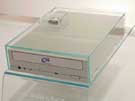
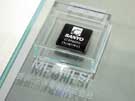
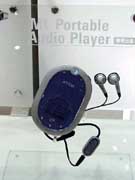
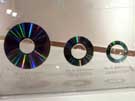 
Now I'm going to describe the most significant events of the last year in a chronological order. In January Philips dissolved a license agreement for CD-R production with Ritek Corporation because the latter didn't comply with the agreement. As it turned out later the Taiwanese Trade Commission proclaimed that Philips, Sony, and Taiyo Yuden violated the local legislation of patent licensing, and Philips was going to withdraw the licence for CD-R production from Ritek. By the way, Philips is charged with using its dominating position not to let other companies prosper on the Taiwanese CD-R market and taking too high commission charges. At the end of January Plextor released its PlexWriter 16/10/40 CD-RW drive which was a response to the Yamaha CRW2100 series.
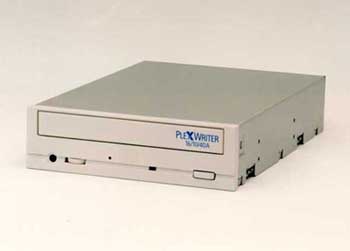 At the Plextor's site there is a complete specification of this drive. The drive at that time was only internal. The retail package included the PlexWriter 16/10/40A drive, 1 blank CD-R, 1 blank CD-R/W, software for WinOnCD + DirectCD recording, Plextor Utility (PlexTools), a user's manual in 16 languages, fasteners, and audio and IDE cables. The PlexWriter 16/10/40 was one of the most advanced devices in its class as it allowed for 16x recording, 10x rewriting and 40x reading. The drive is equipped with the ATAPI interface and can record discs in CD-ROM mode 1 and 2, CD-XA, CD-DA, CD-I, CD TEXT, Video CD and Photo CD formats. It also supports Disk-At-Once, Track-At-Once, Multisession, Packet Writing modes. At the beginning of February TEAC released its new 16x CD-RW drive.
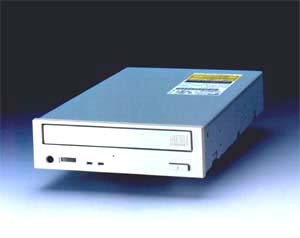 The CD-W516E model had the following specs:
At that time music lovers got into real troubles. The matter was that the most of vendors refused 2x recording in its drives. TEAC went further and refused 12x in its 16x drive! However, there were no CD-R media which would completely comply with 16x record requirements. The CD-RW drive appeared on the shelves at the end of March. A bit later all those announcements were overshadowed by that of Sanyo which unveiled its 24/10/40 CD-RW drives - CRD-BP1500 (ATAPI interface) and CRD-BP5 (SCSI) which were new champions in a recording speed. Sanyo stated that 24x (CD-R) and 10x (CD-RW) were constant linear velocities (CLV). But later it turned out that such a high recording speed was achieved at the expense of the Z-CLV method. When this method is used the whole disc is divided into three fields which are burnt at definite speeds: 16x, 20x and 24x. We can see that CLV recording is implemented in each zone, and thus, it maintains high stability and recording quality.
 Above all, the drive has 130 ms access time, a 2 MBytes buffer and BURN-Proof. Only the ATAPI version is produced. February brought in "live" representatives of the DVD+RW technology. Sony, Thomson Multimedia, Hewlett Packard, Mitsubishi Chemistry, Yamaha, Ricoh and Philips developed a new format named DVD+RW. DVD+RW can help join all members of the DVD forum. The DVD+RW is compatible with usual DVD players. The new format is positioned as a bridge between studios based on a home PC and DVD players. The DVD+RW standard has the following advantages: The comparison was carried out on a DVD+RW drive from Philips and a standard DVD player from Matsushita and showed a lack of compatibility problems with usual DVD devices. After that they recorded a DVD-Video disc on the Ricoh DVD+RW drive built in in the computer and played flawlessly on a usual DVD player. Next day Sony announced a DDCD (Double Density CD) drive CRX200E-RP which is meant for 13 GBytes discs. As you remember, such size is achieved by reducing the distance between adjoining tracks and and the length of pits. The improved error correction mechanism reduces sensitivity to dust and scratches. The Sony CRX200E-RP DDCD has an 8 MBytes buffer and 12/8/32 speeds at an average access time of 125 ms. You can record both usual CD-R/RW discs and DDCD 1.3 GBytes ones. A possibility to write 1.3 GBytes DD-RW discs was provided by a smaller distance between tracks, smaller pits and a new error correction protocol (780 nm wave-length). However, the most of drive and media manufacturers didn't support the Sony's standard. That is why it is quite difficult to find DDCD on sale.
 
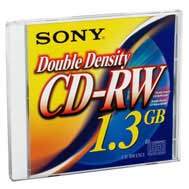 
Despite such a poor debut Sony released in spring an external CD-RW drive CRX2000L of this standard which was available at $310. The CRX2000L is a modification of the CRX2000E model announced in April and coming with the IEEE 1394 interface. The buffer is 8 MBytes and an access time is 150 ms. The drive works at 12/8/32 speeds. Apart from DDCD media the CRX2000L can operate also with CD-RW ones. The drive measures 192 x 272 x 60 mm and weighs 2.8 kg.
 In February TEAC started deliveries of its CD-RW drive CD-RW512S with the SCSI interface. The drive has 12/10/32 speeds and a 4 MBytes buffer; the highest data exchange rate is 20 MBytes/s thanks to the Ultra SCSI interface. The model weighs 2.8 kg. It is one of the highest-quality and the most inexpensive CD-RW drives with the SCSI interface. Shortly before the CeBIT Yamaha announced its latest CD-RW drive CRW2200 with 20/10/40 speeds, a 8 MBytes buffer and SafeBurn support.
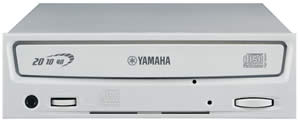 In May Yamaha launched the LightSpeed CRW2200 family with 20/10/40 speeds. The CRW2200 drives allows grabbing a standard 74-minute Audio CD at less than 3 minutes. The series incorporates the Partial Constant Angular Velocity (P-CAV) technology which combines the CAV and CLV ones. The CAV method maintains a constant velocity while a recording speed depends on a zone. The Yamaha LightSpeed includes 5 models:
At the CeBIT 2001 TDK showed off its fastest CyClone 24/10/40 based on the Sanyo pickup coming with a 2 MBytes buffer and BURN-Proof support. Its characteristics are the following:
This model is quite popular with users but the 24x CyClone is not widely available. In April Ricoh Europe published a complete specification of its 20x CD-RW drive MP7200A-DP. The drive has 20/10/40 speeds, ATAPI (Ultra-DMA33) interface, supports JustLink and JustSpeed technologies, and uses a new laser controller with 1.5 better beam focusing; it also has 100 ms access time and consumes less than 1 W in the standby mode. The JustSpeed technology tests a disc type according to the ATIP information and then sets an optimal write speed within the range from 12x to 20x. The drive is equipped with the S/PDIF-out.
 Acer CMA launched its portable CD-RW 6424MU drive priced at $219. The drive came with 6/4/24 speeds, a 2 MBytes buffer, USB 1.1 interface (PCMCIA and Firewire/IEEE 1394 optionally), and 180 ms access time. In September the company released the 1212EF model - an external CD-RW/DVD drive. All three models supports the Seamless Link technology.
 As you know, Philips withdrew licenses for CD-R production from many CD-R makers in Taiwan because they refused to pay high royalties up to $0.045 for each CD-R disc. The licences were temporarily withdrawn from many Taiwanese companies except Acer Computer Technology and Nan Ya Plastics Corp. For a long time Philips held talks with CMC Magnetic for recommancement of the licence agreement and they ended quite peacefully; CMC is currently producing CD-R media and pays a definite sum of money to Philips. Reportedly the European Union Committees decided to expand the antidumping investigation against Taiwanese CD-R manufacturers for two more companies (before they were Ritek, CMC Magnetic and Princo). But the rumors didn't prove to be true. In April Ritek (and a bit later CMC Magnetics) and Philips arranged the differences and started to collaborate again. Ritek resumed production of CD-R media paying a definite sum to the European giant. Yet in spring Ricoh planned to release a new combo drive somewhere in August or September. The MP9200A has the following specification:
This drive is very similar to the Ricoh MP7200, it has just a 10x reading speed for DVD discs. The DVD/CD-RW drive started selling in Japan yet in July.
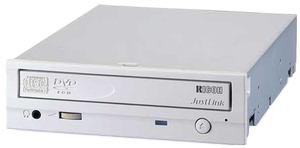 A bit later Ricoh launched its new CD-RW drive MP7163A with 16/10/32 speeds and the following specs:
 A low price and a good price/quality ratio allowed Ricoh to sell out quickly all MP7163A models available in stock. In May TEAC announced a new portable CD-RW drive CD-RW280PU with the USB 2.0 interface. The drive has the following specs:
 At the beginning of July Plextor announced a new 24/10/40 drive PlexWriter PX-W2410A based on the CRD-BP1500P pickup from Sanyo Electric.
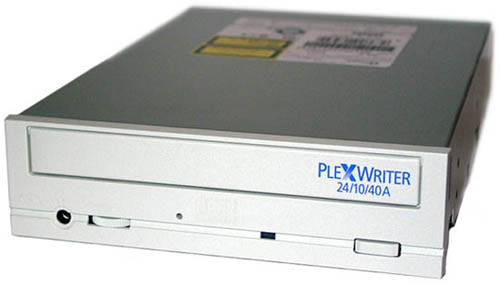 The drive supports Zone-CLV, PoweRec-II (laser power adjustment depending on disc quality), and BURN-Proof technologies. It has Ultra ATA/33 interface, a 2 MBytes buffer and is backed up with the 2-year warranty for Europe, Near East and Africa. A little bit later Plextor started sales of a new internal CD-RW model PlexWriter 8/8/24A SlimLine. It is only 12.7 mm think weighing 250 g. Apart from 8/8/24 speeds the PlexWriter SlimLine has a 2 MBytes buffer, BURN-Proof support and E-IDE (ATAPI-4) interface, being compatible with Windows 98/2000/NT/ME systems on the Plug&Play level. An average access time is 140 ms, a data rate is up to 16.6 MBytes/s (PIO Mode 4/DMA Mode 2).
 On July 11 Mitsumi started sales of its new CD-RW model CR-4808TE equipped with the ExacLink technology from Oak Technology (and its controller - OTI-9796 is used in this drive). The CR-4808TE has 16/8/40 speeds, a 2 MB buffer, ATAPI interface (UDMA/33) and 110 mm access time.
 After the PX-W2410A and the PlexWriter 8/8/24A SlimLine the company released external PlexWriter PX-S88TU drive with the USB 2.0 interface, 8/8/24 speeds, a 2 MBytes buffer and BURN-Proof support. The new model is based on the PX-W88TA, works with 8cm and 12cm discs and comes with drivers for Windows 98SE/Me/2000/XP. It measures 141 x 171 x 22 mm and weights 500 g.
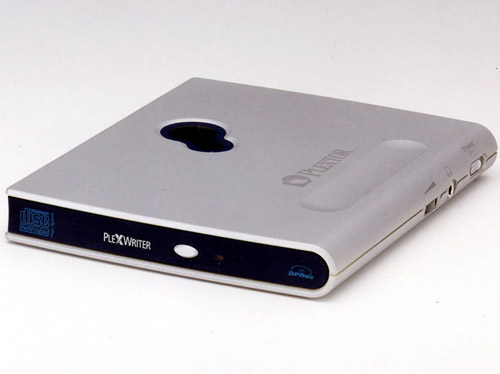 Personal Media Corporation, a Japanese company, released an interesting solution which kills CDs and DVDs; it is called PMC CD-shredder.
 The price is quite original - $1111. I think that I'd better give a disc to a baby or a child to play ;-) In August Ritek and CMC voiced their results for June 2001. Ritek had an income of $60.29 million, and CMC received $47.05 million. Both companies assumed that the second half year will bring them much higher incomes. But they exaggerated. They said that in summer last year CD-R discs were selling at $0.26 - $0.28 wholesale, while at the beginning of 2001 their average price was $0.24, and in the third quarter the company planned a price increase up to $0.30. But the situation turned out to be different. Ritek is sure the global CD-R market will increase by 75% in the near future, and this is not just mere words. On August 20 HP announced a new DVD+RW drive DVD-writer dvd100i. HP plans that DVD+RW discs will be first selling at $15.99 piece which is sometimes less than the price of DVD-RW and DVD-RAM media. The HP DVD-writer dvd100i writes DVD discs at 2.4x and reads at 8x. The standard CD-RW speeds are 12/10/32. The DVD+RW/CD-RW drive MP5120A from Ricoh with the ATAPI interface came onto a scene at the end of September at $480. It is meant for recording of three types - CD-R, CD-RW and DVD+RW, the highest speed of DVD/CD discs is 8/32. In the DVD+RW mode (4.7 GBytes) the drive uses a laser of 650 nm wave length, a pit length is 0.74 micron. In the CD-R/RW record mode the drive supports the JustLink technology.
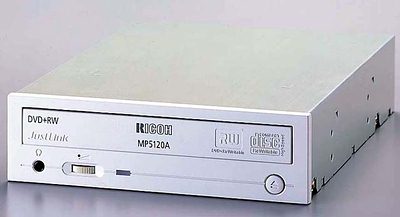 As the new device is just around the corner Ricoh published comparison of functional capabilities of the MP5120A-DP and its competitors:
 Besides, the company released a DVD+RW disc; they will appear on the shelves at $12.
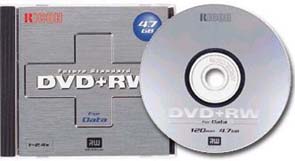 
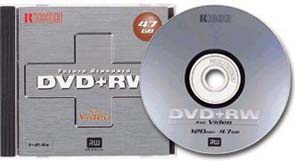 
August was really abundant in the news about DVD+RW standard. Thus, in addition to 4.7 GBytes DVD+RW discs Philips released double-side DVD+RW media of 9.4 GBytes in size which is positioned as a universal solution, i.e. both for video and data.
 Besides, Philips announced a line of new DVD+RW drives. The DVDRW208 drive allows recording DVD+RW discs at 2.4x, and reading DVD at 8x. It also works as a CD-RW drive at 12/8/32 speeds. LEDs notify about a current mode and on a disc type - CD or DVD. The DVDRW208 supports Thermo-balanced Writing (TBW) and Seamless Link technologies. The drive comes with the Sonic Solution MyDVD 3, Roxio Easy CD Creator 5 and DirectCD programs, blank DVD+RW and CD-R discs. This model will be available in October.
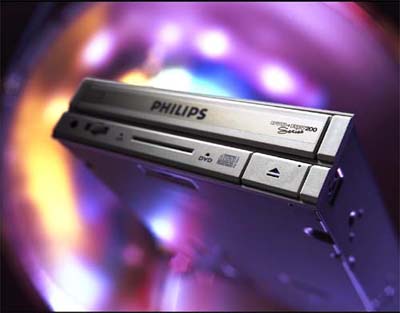 In September Sanyo Japan announced a new line of CD-RW drives CRD-BP1500U which includes two models - internal and external equipped with the USB 2.0 interface. The drives are based on the 1500x pickup and provide 24/10/40 speeds; they also have a 2 MBytes buffer, 130 ms average access time, and BURN-Proof support. The internal model measures 148.0 x 192.4 x 42.3 mm, and the dimensions of the external one are 160.0 x 193.4 x 55.7 mm.
 On September 17 Yamaha Japan launched a new line of CD-RW drives of the 3200x series. All drives provide 24/10/40 speeds, SafeBurn protection and a support of the Mt. Rainier format (CD-MRW). The new drives are named AudioMaster thanks to some technological innovations allowing for higher-quality of discs of the Audio CD format. There will be three versions overall: one internal ATAPI (UltraDMA 33) CRW3200E and two external CRW3200UX-VK with the USB 2.0 interface and CRW3200IX-VK with the FireWire interface. Probably a separate model CRW3200 with the SCSI interface will be absent. There will be just an adapter for the ATAPI model to turn into a SCSI one. The buffer of all models is 8 MBytes. Record formats supported: CD-DA, CD-TEXT, CD-ROM, CD-ROM XA, CD-Bridge(Photo CD), Video CD, CD-i, CD-ROM+CD-DA(Mixed Mode), CD-EXTRA and CD-MRW. The internal model measures 148 x 42.6 x 198.1 mm and weighs 0.9 kg.
 
 
That day Yamaha also launched an external CD-RW model CRW-70 with the USB 2.0 interface and a possibility to play MP3 in the off-line mode. This model will hit the streets in the middle of September. Its characteristics are simple: 12/8/24 speeds, linear-out and a headphones jack provided, MP3 playback at the bitrate up to 192 KBytes/s and SafeBurn supported; it measures 136 x 184 x 29 mm and weighs 560 g.
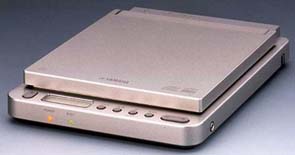 
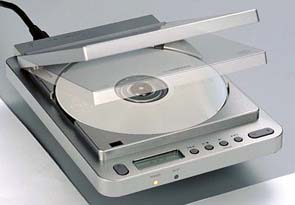 
On September 18 Philips updated its licence page where they published Orange Book Part II Vol2 v1.1 which standardize recording speeds for CD-R up to 32x. Besides, Philips stated that 40x will be achieved by the second quarter of 2002! The major problem for the move to higher speeds is that the PCA (Power Calibration Area) is not acceptable for speeds higher than 24x, and it is necessary to provide extrapolation for operation on inner diameters of a disc. The new technology - PCA2 - lets for a recording speed of 32x and higher on outer diameters of a disc. The PCA2 support is just optional, it creates no compatibility problems and doesn't require any modifications of discs. A week later Ritek announced discs designed exactly for such drives. Production of 32x CD-R media will start in October. And Lite-ON said that it planned to release a 32x CD-RW drive. Probably, soon other drive makers will join it. On the other hand, I can't say the market is glutted with 24x media. Ritek doesn't promise that there will be plenty of 32x discs from the very beginning. In October Oak Technology announced a new controller for CD-R/CD-RW drives - OTI-9797S, which can make it possible to create CD-RW drives with a recording speed of 32X and a reading one of 48X. At 32x a 650 MBytes CD-R can be recorded at a little more than 2 minutes. Besides, it supports the latest interesting standards including Mt. Rainier. The company says 40X recording speed and higher is also just around the corner. In the middle of the fall Hewlett-Packard said that they planned to stop production of all CD-RW drives and move to the recordable DVD market. The price wars on the CD market made all players cut their prices to the minimal ones. That is why HP devices which were never cheap looked attractive just for a small circle of users. Of course, the company won't cease production of CD-RW immediately. The company wants to move gradually from CD-RW to DVD+RW. The company will equip finished solutions of its own production with its CD-RW drives yet for a long time. At the end of October Sanyo launched its new CRD-BP1600P drive with 32/10/40 speeds. It is equipped with the ATAPI interface and a 4 MBytes buffer. An access time in case of disc reading is 130 ms. The drive also supports the BURN-Proof technology. The model measures 148.0 x 192.4 x 42.3 mm.
 Just a few days later Sanyo started shipping its new CRD-SBP15A pickup for external CD-RW drives; it is designed for portable devices. This pickup will serve a base, for example, for the FP-241032 drive with the FireWire interface from TDK.
 The CRD-SBP15A makes it possible to create drives with 24/10/32 speeds (CAV), it is equipped with the ATAPI interface and a 2 MBytes buffer. An access time is 250 ms. The support for BURN-Proof and Shock-BP technologies is provided. The CRD-SBP15A measures 123.0 x 152.0 x 23.0 mm; it has already started shipping to the OEM partners. In November Ricoh started production of its 32x CD-RW drive MP7320A. It has the ATAPI interface, a 2 MBytes buffer and 32 (Z-CLV)/10 (CLV)/48 (CAV) speeds. The MP7320A supports JustLink and JustSpeed technologies. Its average access time in a reading mode is 90 ms. Record methods are Disc At Once, Session At Once, Track At Once, Multi-Session, Packet Writing; record formats are CD-DA, CD-ROM, CD-ROM XA, CD Extra, CD-I, Mixed-Mode CD, VideoCD, PhotoCD, CD TEXT and Bootable CD. The new model is expected in January 2002 „oša. It is interesting that the MP7320 was developed together with Funai Electric which will start its production. On November 13 Sony started production of a DVD+RW drive Sony DRU110/C1which provides 2.4x recording speed for DVD+RW (which is equivalent to 20x for a CD-RW drive). A speed of recording of CD-R and CD-RW is 12x and 10x. The drive uses the DVD+RW pickup from Ricoh. Besides, Sony already started selling DVD+RW discs DPW47 with a recording density of 4.7 GBytes. The recommended price is $16 piece.
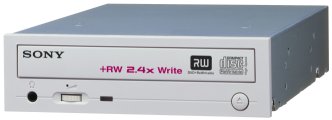 
 
TEAC showed off its new CD-RW drive CD-W524E with the ATAPI interface. The model has 24/10/40 speeds, 80 ms access time in the reading mode, a 2 MBytes buffer and the BURN-Proof support. The drive comes with a good set of software for disc recording.
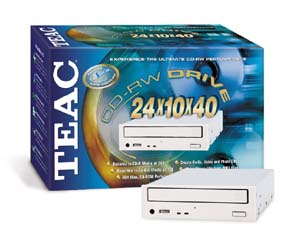 Verbatim started shipping DVD+RW discs certified for operation at speeds from 1x to 2.4x (it is 8x to 20x if we compare with CD-R/RW). The discs are supported by all modern DVD+RW and combo drives, and by home DVD+RW video recording devices. They can be read, of course, by usual DVD-ROM drives as well. The DVD+RW discs from Verbatim support CAV (Constant Angular Velocity) and CLV (Constant Linear Velocity). Verbatim also plans to release DVD+R discs soon. By the end of the fall Ritek and CMC Magnetics cut prices for their products by 10% - 15%. Do you remember their original plans I mentioned earlier? These price cuts will allow them to compete successfully against minor companies which will start leaving market in 2002 when the demand for the media falls down again. Originally Ritek planned to maintain prices at the level of $0.22 -$0.24 but the increase of the demand and a desire to keep a considerable part of the European market resulted in landslide of prices to $0.20 - $0.22 in November. CMC lowered its prices to $0.24 - $0.25 from $0.28. The company said that it wanted to sell out 24x CD-R discs as quickly as possible and move to 32x media. Price cuts for DVD recorders made it possible for Taiwanese manufacturers of optical discs to increase their production volumes. The experts say the sales volumes of DVD-R products in 2002 may be at least 10 times greater than in 2001. For example, in 2001 CMC Magnetics produced about 1,000,000 DVD-R discs, and in 2002 they plan on 30 million discs. Thanks to the licences from Pioneer (DVD-R production technology) and Mitsubishi (coating material) CMC has a little advantage over other Taiwanese disc makers. Ritek produced a little less than 1 million DVD-R discs in 2001, and in 2002 it plans on over 10 million. The equipment for CD-R production bought by the company during last two years needs only slight alterations for transition to the DVD-R platform. Prodisc has already two production lines for DVD-R of the output of 1 million discs a year. According to the company the current lines for CD-R production can also be modified for DVD-R with the output of 10 million discs a year. Gigastorage has already launched one DVD-R line and plans by the second half-year of 2002 to redesign the CD-R lines for production of DVD-R discs. Infodisc has already tested the equipment for DVD-14 and DVD-18 discs, but the company isn't going to unveil its future plans so far. Well, as soon as prices for DVD-R drives go down rapidly the demand for media will increase, and their prices will start falling we well. However, we should ignore the competitors - DVD-RAM and DVD+RW standards. The competition will hardly make for price cuts. But we should remember that according to the members of the DVD+RW alliance the DVD-R format will be compatible with DVD+RW drives. On December 8 TDK Europe released a new line of 32x CD-RW drives CyClone with 32/10/40 speeds. The new drive has 130 ms access time in a reading mode and a 4 MBytes buffer and supports the BURN-Proof technology. At the end of December only an internal ATAPI model AI-321040 will come onto a scene. The external FE-321040 model with the FireWire interface ix expected to appear in February 2002, while the UE-321040 model (USB 2.0) must arrive in March 2002.
 No secret that Lite-On has a pickup for 32x recorders. Not so long ago they published specifications of the new 32x CD-RW drive LTR-32123S:
After the leading CD-R manufacturers lodged a complaint the European Union Trade Commission promulgated a resolution of December 19 2001 on a considerable tariff for CDs coming from Taiwan. The complaint was about unfair competition and underpricing of Taiwanese CD-R media manufacturers. They pointed to facts of considerable price cuts for CD-R discs produced by leading Taiwanese plants. The Commission established dues for CD-R media imported to the European Union at 18.8% - 39.5%. Now importers of Ritek discs will have to pay 18.8%, and those of Princo media - 29.9%. The expected price growth caused a significant
demand for CD-R discs in Europe. Such excitement will last at least
two months until all old discs are sold out.
Write a comment below. No registration needed!
|
Platform · Video · Multimedia · Mobile · Other || About us & Privacy policy · Twitter · Facebook Copyright © Byrds Research & Publishing, Ltd., 1997–2011. All rights reserved. |